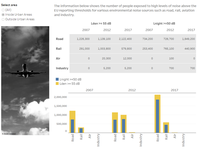
These country fact sheets summarise information on noise pollution for selected EEA member countries. The fact sheets are based on the latest official noise data reported every five years by EEA member countries under the Environmental Noise Directive (END).

These country fact sheets summarise information on noise pollution for selected EEA member countries. The fact sheets are based on the latest official noise data reported every five years by EEA member countries under the Environmental Noise Directive (END).

These country fact sheets summarise information on noise pollution for selected EEA member countries. The fact sheets are based on the latest official noise data reported every five years by EEA member countries under the Environmental Noise Directive (END).

These country fact sheets summarise information on noise pollution for selected EEA member countries. The fact sheets are based on the latest official noise data reported every five years by EEA member countries under the Environmental Noise Directive (END).

These country profiles summarise information on noise pollution for each of the EEA-33 member countries. The profiles are based on the latest official noise data reported every five years by EEA member countries under the Environmental Noise Directive (END).

Landscape fragmentation is the physical disintegration of continuous ecosystems into smaller units, which is most often caused by urban or transport network expansion. Breaking structural connections between habitats results in decreased resilience of habitats and a decrease in their ability to provide various ecosystem services and support biodiversity. This dashboard enables the exploration of landscape fragmentation in 2018 in Europe.

The Directive relating to the assessment and management of environmental noise (the Environmental Noise Directive – END, 2002/49/EC) is the main EU instrument to identify noise pollution levels and to trigger the necessary action both at Member State and at EU level.

Vegetation productivity indicates the spatial distribution and change of the vegetation cover - a key characteristic of ecosystem condition. Climatic variations are important drivers of vegetation productivity, but land use changes are even stronger. Productivity in Europe increases most due to agricultural land management and converting other lands to agriculture, whereas largest decrease is caused by sprawling urban areas. The dashboard below enables the exploration of these processes during 2000-2018.

Functional Urban Areas (FUAs) represent 22.9 % of the EU territory, but host 75 % of its population. In order to fulfil global and European policy objectives, like “no net land take by 2050”, it is advisable to establish guidance values for land use efficiency for most common settlement types, in particular for urban fringes and small towns in rural areas. Such guidance values need to consider a good balance between efficient land use and sufficient green space to allow a good quality of life. This dashboard presents land use efficiency values for FUAs, calculated as land uptake per capita corresponding to the SDG indicator 11.3.1.

Trees in urban areas have multiple benefits for human well being and for biodiversity as well as for carbon sequestration, climate change adaptation and flood protection. The below dashboard presents urban tree cover statistics for Functional Urban Areas in the EU27+UK and for the EEA 38+UK region, by countries. The dashboard will be updated every 3 years after the availability of the Copernicus Land Monitoring Service products Urban Atlas, Tree Cover Density and Street Tree Layer.

Data submited by countries up to 01/01/2021

The figure shows the supply, production, import, export and destruction of F-gases (CO2e) from 2015 to 2020

The figure shows the supply, production, import, export and destruction of F-gases (tonnes) from 2015 to 2020

The figure shows the EU progress towards hydrofluorocarbons phase-down objectives under EU domestic targets and under the Montreal Protocol in Mt CO2e from 2015 to 2036

Data submited by countries up to 01/01/2021

Data are supplied by the countries for the annual reports "Forest Fires in Europe, Middle East and North Africa 20nn" series.

The urban waste water treatment map shows the most recently reported information on the implementation of the Urban Waste Water Treatment Directive (UWWTD). It is based on data from 2020 in EU-27 (2020) countries plus Iceland, which were reported by countries in 2022. Data are provisional, pending compliance assessment by the European Commission.


The pan-European High-Resolution Vegetation Phenology and Productivity product suite (HR-VPP) are provided at a high spatial resolution (10 m x 10 m) with a high repeat frequency. They are derived from the optical Sentinel-2 constellation data (Sentinel-2A and Sentinel-2B) with a revisit time of 5 days. They are generated over the entire EEA39 region (33 member countries and 6 cooperating countries) from January 1 2017 onwards, with a daily, 10-daily and yearly frequency (see below).
The HR-VPP product suite contains 3 product groups, 31 product types, 1522 files and more than 900.000 tiles per year, which totals more than 80 Terra Bytes of data, per year.